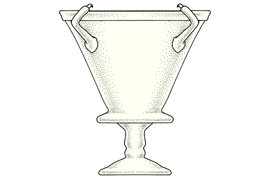|
Introduction
First came the Persian army of Chosroes II, that
sacked Jerusalem in A.D. 614. Eight years later the emperor Heraclius
did re-capture the city, but respite for the Byzantine world was
brief. In A.D. 638 the forces of Islam swept westward and overwhelmed
the entire eastern Mediterranean shoreline.
In the battle-strewn
landscape that once had been Rome's eastern provinces, glassworking
reverted more and more to a local craft level. New centers of glassworking
emerged throughout Iran and Iraq, seeking now to satisfy the needs
and tastes of Baghdad, not Constantinople. And many glass workshops
were kept busy, making lamps for the thousands of mosques that were
constructed in the Islamic world over the next few centuries.
Traditional
"bowl-and-stem" lamps continued to be popular throughout
the Islamic era. But Islamic glassworkers, like their Byzantine
counterparts, were always willing to adapt household glassware, such as wine vessels, into
lamps any way they could.
|
|

Solidus of
Emperor Heraclius
A.D. 610641

Lamp adapted from a wine cup
9th century A.D.
|
REFERENCES
1) Chadwick, H. and Evans, G.R., 1989: Atlas
of the Christian Church, 32-40 (New York: Facts on File).
2) Cool, H.E.M., 1995: "Glass Vessels
of the Fourth and Early Fifth Century in Roman Britain," in
Le Verre de l'Antiquite Tardive et du Haut Moyen Age, 11-23,
ed., D. Foy (Val d'Oise: Cergy-Pontoise Musée Archéologique
Departemental).
3) Fleming, S.J., 1999: Roman Glass:
Reflections on Cultural Change, 131-136 (Philadelphia: University of Pennsylvania
Museum).
4) Foy, D. and Sennequier, G., 1989: À
travers le verre du Moyen Age à la Renaissance, (Rouen:
Musées departementaux de la Seine-Maritime).
5) Pinder-Wilson, R.H. and Scanlon, G.T.,
1987: "Glass Finds from Fustat: 1972-1980," Journal
of Glass Studies 29, 60-71.
|

